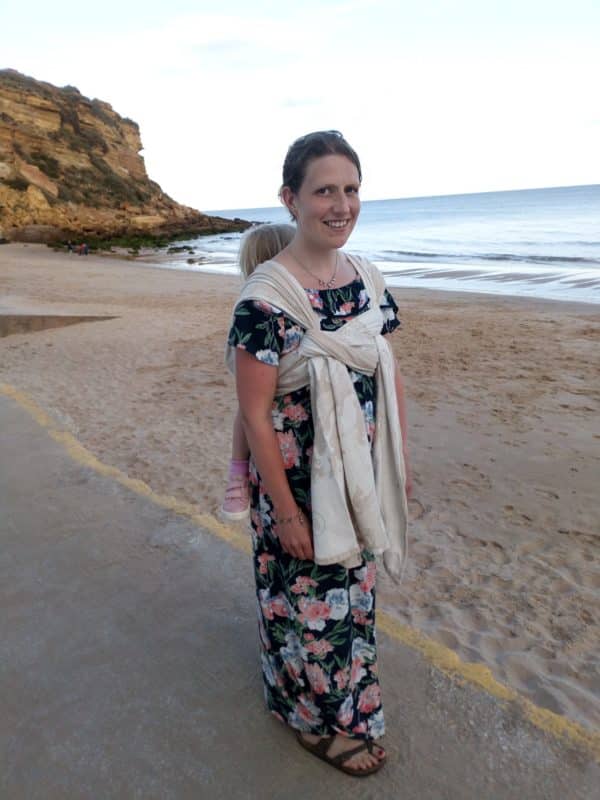Using Woven Wraps
Knotless Ruck or Ruck Tied Under Bum: Wrapping Tutorial
Knotless Ruck or Ruck Tied Under Bum
The ruck or rucksack carry is a single pass (one layer of wrap covering the baby) back carry. For a standard ruck the tails of the wrap would be passed around your waist and knotted at the front. You may not have enough length to do this with a short wrap, or just prefer not have the wrap tied across your middle, so the knotless finish or tying under bum (often abbreviated to TUB) provides you with two different options for fastening off the ruck carry using a shorter wrap.
- Ruck carries are simple and quick to tie. They can be adapted to be done using a variety of lengths of wrap
- They are a two shouldered back carry, evenly distributing weight across your body
- As this is such a basic carry to tie it can be great for beginners to learn with, but there are no extra steps that will compensate for or disguise issues with technique. The two key areas to get right with this carry are making the ‘seat’ that supports the baby and evenly distributed, snug tightening. If you address these issues then the ruck carry is very secure and supportive. They underpin the comfort of all carries, so improving your ‘ruck skills’ will improve your performance of every other carry you do. Some people are anxious about the baby ‘popping’ their seat, but improving your technique is simple to do (although can seem counter-intuitive at first until you understand the mechanics of how a secure seat works).
- It is great for quick ups and downs which is handy for older babies and kids that just get a little tired.
- It is also a nice high, supportive and comfortable carry with a single pass which makes it great for carrying smaller babies.
- Tying under bum can allow you to use a much shorter wrap than you would normally use for a two shouldered carry
- Knotless finishes don’t cut across your tummy and some people find them more comfortable. There are lots of adaptations for knotless finishes.
- The ruck can be adapted by reinforcing it in a few different ways. With a short wrap, you can start off centre and secure with a rope pass above the legs. You could also extend this pass up baby’s back as a supporting pass. With a longer wrap, you can start with the middle marker in the centre of baby’s back and, when passing your ruck straps behind you can extend both passes up baby’s back for even more support.
The ruck is a great place to start when starting to back carry. There are lots of possibilities when it comes to a ruck. You can tie (knot) under bum (TUB) which gives you just one pass over baby or you can reinforce your ruck either using one long pass as a rope across the bottom under baby’s legs or bringing that pass up across baby’s back as a second pass.
Here is a GIF tutorial of Erin doing a knotless ruck in a size 2 Rigel Aqua Starmap.
Some useful points to remember when performing a ruck carry
A secure seat doesn’t need to be deep, with lots of fabric pulled up between you
-
- Wrap fabric wants to ‘work’ in straight lines, so no matter how much slack fabric you pull up between your baby’s legs, it won’t stay pinned between you and your baby. That slack (which you might have tucked into baby’s waistband as you were putting them on your back as a means of creating a ‘deep seat’) is just going to work its way out, either as you tighten the carry or over time as you carry, your baby will sink into a deepening pocket of fabric and there will be no tension in the bottom rail to keep baby sat in a pouch, allowing it to ‘pop’.
-
- What you need is for the cloth to be nice and taut from one of baby’s knee-pits to the other. When you do this, even a few inches of cloth will be enough to hold your baby securely. Try holding the wrap at one of baby’s knee-pits then using the other hand to pull the wrap across in a straight, tensioned line to reach the other knee-pit. As your baby naturally sinks their bottom lower than their knees in the carry, that will create a ‘deckchair’ like effect which will support their weight, even if they bounce their bottoms up and down out of the cloth.
- Stand up as straight as you can when you wrap. When you bend forwards, your child’s weight is carried on your torso, but as you stand back up again their weight transfers downwards. If you stand up as soon as you can and allow their weight to fall naturally then you can tighten the carry effectively and won’t find pockets of trapped slack working their way through the carry, or that you are suddenly carrying all of the load through your shoulders
- Pay attention to tightening. If you have created a good seat to begin with then the bottom part of the wrap should need very little tightening at all, and over tightening it can actually be unhelpful! Tightening the centre of the wrap will help to transfer the child’s weight through your whole body rather than having them ‘hang’ on your shoulders. Tightening the top 3rd of the wrap will stop your child from pulling back away from you- this can make them feel very heavy and sag. Once you have tightened the wrap in sections over your shoulder and passed that strap under the child’s bum, try taking hold of the whole strap with the hand of the shoulder that it is coming down from and pulling gently down, whilst using the other hand to pull on that tail and guide it under and past their bottom a little further. It is an ‘L’ shaped movement- with the hand next to the shoulder strap pulling the cloth down, and the other hand pulling it horizontally to the other side. You can sometimes gain a few extra inches of fabric in the tail this way and really snug your child up close against you (which helps to better distribute their weight against you and ensure they keep a good posture)
 |
 |
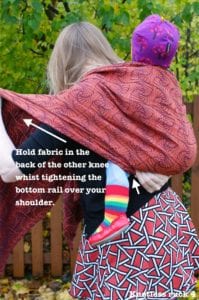 |
 |
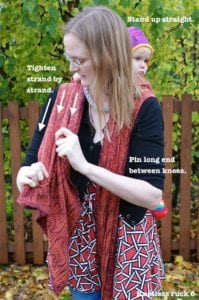 |
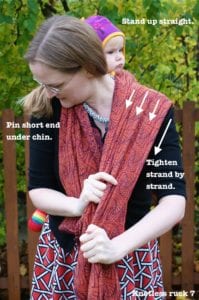 |
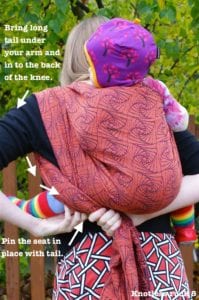 |
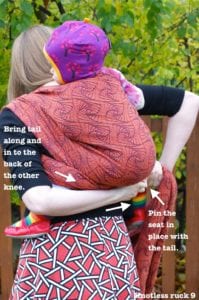 |
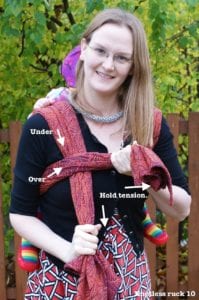 |
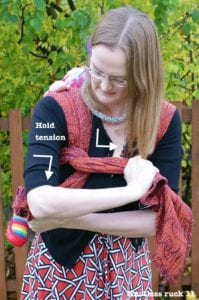 |
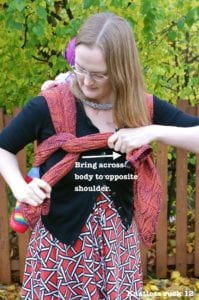 |
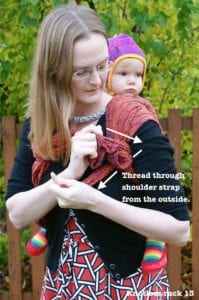 |
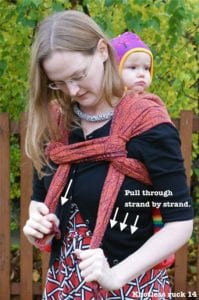 |
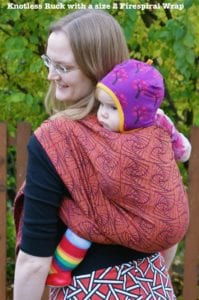 |
Here is another GIF tutorial. This one is of a Ruck Tied Under Bum (TUB):
